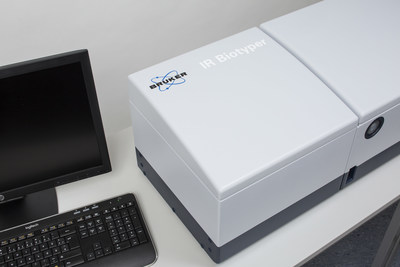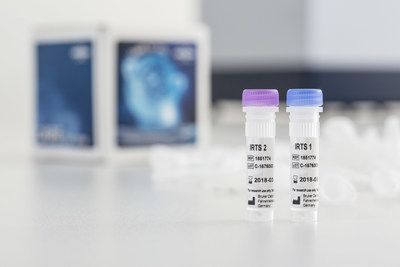Bruker Introduces New Solutions for Microbial Strain Typing, Hospital Hygiene and Infection Control at the ASM Microbe 2017 Meeting
- Novel IR Biotyper™ System Enables Fast, Routine and Cost-effective Strain Typing for Hospital Infection Control and Earlier Detection of Outbreaks due to Multi-Resistant Strains,
- MALDI Biotyper®-based KPC Microbial Subtyping to detect Klebsiella pneumoniae strains carrying the plasmid containing the carbapenemase-encoding blaKPC gene;
NEW ORLEANS, June 1, 2017 /PRNewswire/ -- At the American Society for Microbiology (ASM) Microbe 2017 meeting (www.asm.org), Bruker introduces major innovations for strain typing, hospital hygiene and infection control.
The novel, bench-top IR Biotyper system for microbial strain typing is based on Fourier-Transform Infrared (FTIR) spectroscopy technology, and complements Bruker's world-leading MALDI Biotyper mass spectrometry platform for fast microbial identification from cultures using protein fingerprinting. The IR Biotyper uses many classes of biomolecules, like lipids, proteins, nucleic acids and polysaccharides simultaneously to characterize a microbial sample by strain-specific absorbance patterns in the infrared spectrum. Various biomolecules can contribute to this pattern, which makes the IR Biotyper an efficient tool for fast and cost-effective strain typing.
The IR Biotyper system can be used stand-alone for routine hospital hygiene and infection control, as it is capable of providing results on dozens of hygiene samples over-night, or it can be combined in a workflow with parallel microbial species identification by the MALDI Biotyper. Due to its fast time-to-result (TTR), excellent strain differentiation performance, low cost per sample, ease of use, robustness and throughput, the IR Biotyper can perfectly complement next-generation sequencing (NGS) strain-typing results, which typically require more time, training and infrastructure in core labs.
The IR Biotyper is easy to use without any prior knowledge of FTIR technology. Its workflow uses a colony from an agar plate, typically after overnight incubation. The assay needs only a few minutes of hands-on time. The complete routine workflow is supported by the new IR Biotyper Kit that allows standardized and straight-forward sample preparation, and contains proprietary test standards for quality control. The IR Biotyper supports 96-well plates, which can be used for up to 30 individual samples per run. Each sample is measured in a few minutes. The IR Biotyper software offers a simple user interface for the set-up of automated, unattended runs. The software also includes data interpretation with optimized statistical algorithms and provides clear visualization of the results, for example, as a distance matrix, or as a dendrogram of multiple isolates.
With its easy, user-friendly workflow, fast turn-around time and cost-effective sample preparation, the IR Biotyper enables new in-house workflows in hospital infection control. More samples can be analyzed prospectively in less time and at a lower cost compared to molecular technologies in hygiene laboratories. Results are generated directly after the measurements. This also improves sample logistics as many samples that previously had to be sent to central core molecular testing facilities can now be analyzed directly in the hospital hygiene laboratory. The IR Biotyper is for research-use-only and not for diagnostic use.
Dr. Jan Liese, Head of Hospital Hygiene at the University Hospital Tübingen, Germany, stated: "The spread of pathogens in hospitals, in particular of multi-resistant strains, is an increasing threat for patients' health today. The early detection of a potential outbreak is an important prerequisite to apply appropriate and timely infection control measures and to reduce the number of pathogen transmissions. We found that the IR Biotyper is an easy to use device, which features short sample analysis times and a clear data presentation. It thereby represents a promising typing tool that is suitable for a near to real-time observation of pathogen transmissions on the strain level, thereby enabling a very early intervention. This has the potential to improve patient care by prevention of hospital infections and reduction of hospital costs due to patient isolation."
In addition, Bruker also introduces a new software module for MALDI Biotyper-based subtyping. This new software detects Klebsiella pneumoniae strains carrying a plasmid that is responsible for carbapenem resistance (KPC). A novel algorithm automatically detects a specific protein peak encoded by the pKpQIL plasmid with the blaKPC gene. When activated, this optional strain detection occurs automatically during a standard microbial identification run, with simultaneous species identification and KPC strain detection results. KPC-producing Klebsiella pneumoniae strains are a severe public health problem in an increasing number of countries, and rapid methods for their detection are needed by the clinical community. The new KPC subtyping module is for research-use-only and is not for diagnostic use.
Dr. Wolfgang Pusch, Executive Vice President for Microbiology & Diagnostics at Bruker Daltonics, added: "At the ASM Microbe Meeting 2017 Bruker is further expanding its offering in clinical microbiology with innovative tools for improved infection control. While the MALDI Biotyper has its strength in fast, broad and cost-effective microbial species identification, the IR Biotyper enables fast, routine and pre-emptive strain typing in hospital hygiene and infection control. We are pleased that once again Bruker provides innovations that have high potential to improve the standard of care in hospital or other healthcare settings, while at the same time making infection control in the healthcare system more routine and more cost effective."
About the Bruker MALDI Biotyper (MBT) Platform
The MALDI Biotyper family of systems enables molecular identification of microorganisms like bacteria, yeasts and fungi. Classification and identification of microorganisms is achieved reliably and quickly using proteomic fingerprinting by high-throughput MALDI-TOF mass spectrometry. The MALDI Biotyper uses a molecular approach based on specific proteomic fingerprints from bacterial strains. Many published studies have highlighted the greater accuracy and lower cost offered, as well as typically much faster time-to-result (TTR).
Applications of various MALDI Biotyper solutions include clinical routine microbial identification, environmental and pharmaceutical analysis, taxonomical research, food and consumer product safety and quality control, as well as marine microbiology. In many European and international laboratories the MALDI Biotyper has replaced classical biochemical testing for bacterial identification in the past few years due to the accuracy, speed, extensive species coverage, ease of use and cost effectiveness of the system. Traditional biochemical techniques detect different metabolic properties of microorganisms, can take many hours or even days for completion, and they often lack specificity.
The robust MALDI Biotyper requires minimal sample preparation and offers low consumables cost. The products of the MALDI Biotyper family are available in a research-use-only (RUO) version, as the U.S. FDA-cleared MALDI Biotyper CA System, or in an IVD-CE version according to EU directive EC/98/79. The MALDI Biotyper also has medical device registrations in numerous other countries. RUO versions of the MALDI Biotyper allow selected, high-value antimicrobial resistance tests.
About Bruker Corporation (NASDAQ: BRKR)
For more than 55 years, Bruker has enabled scientists to make breakthrough discoveries and develop new applications that improve the quality of human life. Bruker's high-performance scientific instruments and high-value analytical and diagnostic solutions enable scientists to explore life and materials at molecular, cellular and microscopic levels.
In close cooperation with our customers, Bruker is enabling innovation, productivity and customer success in life science molecular research, in applied and pharma applications, and in microscopy, nano-analysis and industrial applications. In recent years, Bruker has also become a provider of high-performance systems for cell biology, preclinical imaging, clinical phenomics and proteomics research, clinical microbiology, and for molecular pathology research. For more information, please visit: www.bruker.com.
Investor Contact:
Miroslava Minkova
Bruker Head of Investor Relations
T: +1 (978) 663–3660, ext. 1479
E: [email protected]
Contact for Media and Customers:
Dr. Wolfgang Pusch
Executive Vice President for Microbiology & Diagnostics
Bruker Daltonics Division
Tel: +49-421-2205-270
E: [email protected]
SOURCE Bruker Corporation
Related Links
WANT YOUR COMPANY'S NEWS FEATURED ON PRNEWSWIRE.COM?
Newsrooms &
Influencers
Digital Media
Outlets
Journalists
Opted In



Share this article